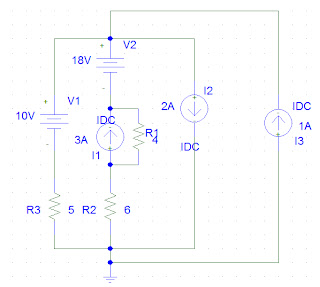METHODS:
We want to increase the voltage range of the sensor. The range of Vsensor is 0-1V and 0-10V range for the micro-controller. The operation amplifier (op-amp) offers an ideal solution to the problem. We will use the LM741 op-amp (pin diagram shown in Figure 1). The current into the LM741 must be less than 1mA; additionally, the op-amp power supplies should supply no more than 30mW of power each. The circuit should be designed with standard 1/4 W resistors. The circuit is an inverting amplifier with a gain of -10 as shown in Figure 2.
 |
| Figure 1: LM741 Pin Diagram (NC= NO CONNECTION) |
We represent the sensor that produces a voltage which varies between 0V and 1V. We create a voltage divider to synthesize Vin. If Rx and Ry are much smaller than Ri, then the inverting amplifier will not appreciably "load" the divider circuit.
Calculations:
We calculate Ri using Ohm's law and the conditions for the sensor voltage and current into op-amp. 1V=Ri(1mA) >> Ri = 1kOhm
We can determine the feedback resistor Rf using the proportionality of the input and output voltages of the op-amp; we assume the op-amp to be ideal. Thus,
Vout=Rf/Ri*(Vin) >> Rf = Vout/Vin*(Ri) -- Vout=10V, Vin=1V, Ri=1kOhm >> Rf= 10kOhm
To determine Rx, we assume that we want it to be a standard 1/4 W resistor operating at half its rated power. The worst case across Rx occurs when Ry is 0. Thus,
PRx=(Vs^2)/Rx >> Rx=(Vs^2)/PRx >> PRx(Max power dissiapted by Rx)= 1/4W*1/2=1/8 W, Vs = 6V and 12 V
Accordingly, Rx = 288 Ohm, 1152 Ohm for Vs = 6V, 12 V
For Ry we use a voltage divider assuming that the op-amp does not load the sensor circuit.
Vin=(Ry*Vs)/(Rx+Ry) >> Ry = 57.6 Ohm, 26.2 Ohm for Vs = 6V, 12V
We determine the Thevenin Equivalent of the divider looking back to the left of Ri.
Where Rth = Rx + Ry and Vs = 6 V, 12 V respectively.
We see that the the Thevenin resistance is not at least 20 times less than the resistance value for Ri = 1kOhm. To achieve the output of 1V across Ri, we use a potentiometer for Ry and adjust it until we reach the desired voltage value.
DATA:
Component Data Table
| Component | Nominal Value | Measured Value | Power/Current Rating |
| Ri | 1 kOhm | 0.96 kOhms | 1/8 W |
| Rf | 10 kOhm | 10.09 kOhms | 1/8 W |
| Rx | 288/1152 Ohm | 287/1152 Ohms | 1/8 W |
| Ry | 57.6/26.2 Ohm | 58/27 Ohms | 1 W |
| V1 | 6/12 V | 6.06/12.02 V | 2 Amp |
| V2 | 6/12 V | 6.06/12.02 V | 2 Amp |
6 V Power Supplies Data Table
| Vin | Vout | Gain | Vri | Iri | VRf |
| 0.00 V | 0.07 V | 0.00 | 8.9 mV | 9.27 uA | 90.1 mV |
| 0.25 V | 2.70 V | 10.80 | 264 mV | 0.275 mA | 2.66 V |
| 0.50 V | 4.02 V | 8.04 V | 0.39 V | 0.406 mA | 4.12 V |
| 0.75 V | 4.02 V | 5.36 V | 0.42 V | 0.438 mA | 4.36 V |
| 1.00 V | 4.02 V | 4.02 V | 0.44 V | 0.458 mA | 4.62 V |
12 V Power Supplies Data Table
| Vin | Vout | Gain | Vri | Iri | VRf |
| 0.00 V | 0.00 V | 0 | 4.40 mV | 4.58 uA | 52 mV |
| 0.25 V | 2.60 V | 10.4 | 0.25 V | 0.26 mA | 2.73 V |
| 0.50 V | 5.20 V | 10.4 | 0.54 V | 0.56 mA | 5.61 V |
| 0.75 V | 7.70 V | 10.27 | 0.75 V | 0.78 mA | 7.76 V |
| 1.00 V | 9.80 V | 9.8 | 0.95 V | 0.99 mA | 9.85 V |
We can see the saturation of the op-amp from the output voltages of the 6V Power Supply Data Table; hence, the reasoning for the switching the experiment to use a 12 V power supply.
Next we insert an ammeter in series with the +/-Vcc inputs on the op-amp; we measure the current leaving each power supply, Iv1, Iv2 respectively.
Iv1 = 0.503 mA
Iv2 = 1.48 mA
Lastly we calculate the power deliver by each of the power supplies, V1 & V2. Where, V1=V2=12.02V, Pv1= Iv1*(V1), Pv2 =Iv2*(V2)
Pv1 = 6.05 mW
Pv2 = 17.7 mW
QUESTIONS
-If we assume the currents into the non-inverting and inverting terminals are zero, based on power supply currents and calculated current through Rf, show that KCL is satisfied for condition, Vin = 1.00V.
-Solution:
-Do we satisfy the power supply constraint to supply no more than 30mW each? If we wanted to reduce the power drawn from the power supplies even more, how could we modify our design to accomplish this without changing the amplifier gain?












